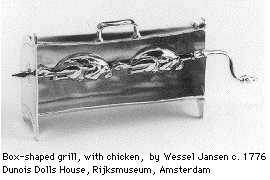 An
iron meat turning grill with its parts; a wooden grill, 'een yser
spith met sijn toebehooren; een houte spith', in the back
kitchen, room J.
An
iron meat turning grill with its parts; a wooden grill, 'een yser
spith met sijn toebehooren; een houte spith', in the back
kitchen, room J.
 An
iron meat turning grill with its parts; a wooden grill, 'een yser
spith met sijn toebehooren; een houte spith', in the back
kitchen, room J.
An
iron meat turning grill with its parts; a wooden grill, 'een yser
spith met sijn toebehooren; een houte spith', in the back
kitchen, room J.
The iron turning grill was used to grill freshly slaughtered meats, especially fowl. Fresh meat was more expensive than smoked meat or salted meat. Was this grill placed all the way ion the back because of the smoke it yielded?
A fine book on the art of cooking in the 17th century: Marleen Willebrands, De verstandige Kok, De rijke keuken van de Gouden Eeuw, Publisher: Pereboom, Bussum, 2006.
Note : This object was part of the Vermeer-inventory as listed by the clerk working for Delft notary public J. van Veen. He made this list on February 29, 1676, in the Thins/Vermeer home located on Oude Langendijk on the corner of Molenpoort. The painter Johannes Vermeer had died there at the end of December 1675. His widow Catherina and their eleven children still lived there with her mother Maria Thins.
The transcription of the 1676 inventory, now in the Delft archives, is based upon its first full publication by A.J.J.M. van Peer, "Drie collecties..." in Oud Holland 1957, pp. 98-103. My additions and explanations are added within square brackets [__]. Dutch terms have been checked against the world's largest language dictionary, the Dictionary of the Dutch Language (Woordenboek der Nederlandsche Taal , or WNT), which was begun by De Vries en Te Winkel in 1882.
Illustration taken from the recently published handbook on Dutch Doll Houses by Jet Pijzel-Dommisse,Het Hollandse pronkpoppenhuis, Interieur en huishouden in de 17de en 18de eeuw, Waanders, Zwolle; Rijksmuseum, Amsterdam, 2000, ill.270.
This page forms part of a large encyclopedic site on Vermeer and Delft. Research by Drs. Kees Kaldenbach (email). A full presentation is on view at johannesvermeer.info.
Launched December, 2002; Last update March 2, 2017.
Back to the Welcome page: click Welcome.